SITHKOP005: Food Production Planning, Coordination, and Quality
VerifiedAdded on 2023/04/20
|14
|4419
|102
Report
AI Summary
This report addresses the SITHKOP005 assessment, focusing on planning, organizing, coordinating food production, and monitoring kitchen output quality within a university's centralized production kitchen. It analyzes the establishment's food service styles (buffet, Australian, platter to plate, and family service) and determines the most suitable food production system (bulk food production and fresh cooking) based on factors like food production requirements, menus, nutritional value, and food structure. The report outlines considerations for each step in the food production process, including receiving, mise en place, cooking, storage, reconstitution, re-thermalization, and serving. It includes a selection of appropriate menu items, justifications for their choice, and a detailed workflow schedule addressing dietary needs, ingredient availability, and resource management. The document also features a mise en place plan for vegetable preparation and discusses how production volumes influence preparation lists, offering a comprehensive view of coordinating cooking operations.
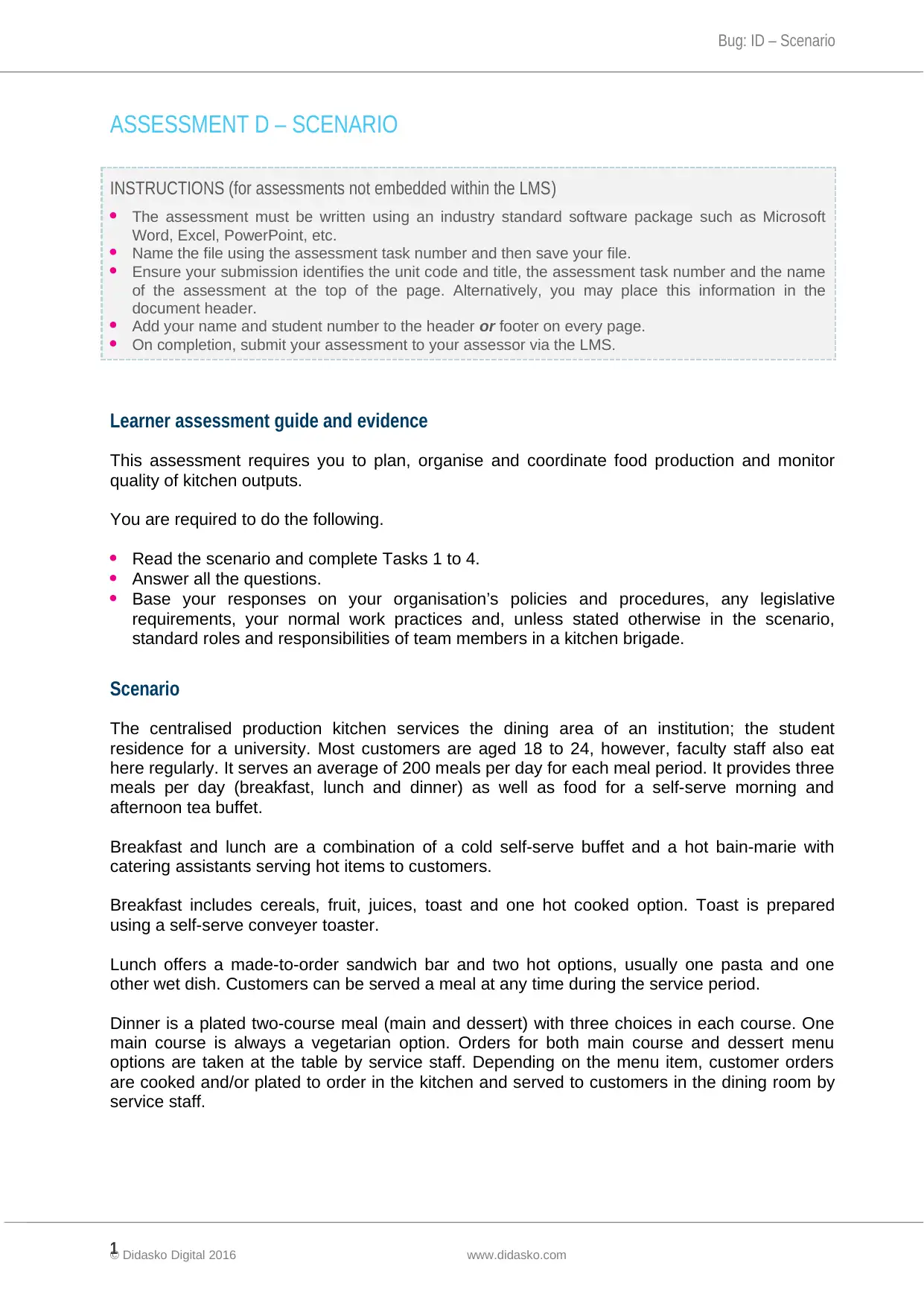
Bug: ID – Scenario
ASSESSMENT D – SCENARIO
INSTRUCTIONS (for assessments not embedded within the LMS)
The assessment must be written using an industry standard software package such as Microsoft
Word, Excel, PowerPoint, etc.
Name the file using the assessment task number and then save your file.
Ensure your submission identifies the unit code and title, the assessment task number and the name
of the assessment at the top of the page. Alternatively, you may place this information in the
document header.
Add your name and student number to the header or footer on every page.
On completion, submit your assessment to your assessor via the LMS.
Learner assessment guide and evidence
This assessment requires you to plan, organise and coordinate food production and monitor
quality of kitchen outputs.
You are required to do the following.
Read the scenario and complete Tasks 1 to 4.
Answer all the questions.
Base your responses on your organisation’s policies and procedures, any legislative
requirements, your normal work practices and, unless stated otherwise in the scenario,
standard roles and responsibilities of team members in a kitchen brigade.
Scenario
The centralised production kitchen services the dining area of an institution; the student
residence for a university. Most customers are aged 18 to 24, however, faculty staff also eat
here regularly. It serves an average of 200 meals per day for each meal period. It provides three
meals per day (breakfast, lunch and dinner) as well as food for a self-serve morning and
afternoon tea buffet.
Breakfast and lunch are a combination of a cold self-serve buffet and a hot bain-marie with
catering assistants serving hot items to customers.
Breakfast includes cereals, fruit, juices, toast and one hot cooked option. Toast is prepared
using a self-serve conveyer toaster.
Lunch offers a made-to-order sandwich bar and two hot options, usually one pasta and one
other wet dish. Customers can be served a meal at any time during the service period.
Dinner is a plated two-course meal (main and dessert) with three choices in each course. One
main course is always a vegetarian option. Orders for both main course and dessert menu
options are taken at the table by service staff. Depending on the menu item, customer orders
are cooked and/or plated to order in the kitchen and served to customers in the dining room by
service staff.
© Didasko Digital 2016 www.didasko.com1
ASSESSMENT D – SCENARIO
INSTRUCTIONS (for assessments not embedded within the LMS)
The assessment must be written using an industry standard software package such as Microsoft
Word, Excel, PowerPoint, etc.
Name the file using the assessment task number and then save your file.
Ensure your submission identifies the unit code and title, the assessment task number and the name
of the assessment at the top of the page. Alternatively, you may place this information in the
document header.
Add your name and student number to the header or footer on every page.
On completion, submit your assessment to your assessor via the LMS.
Learner assessment guide and evidence
This assessment requires you to plan, organise and coordinate food production and monitor
quality of kitchen outputs.
You are required to do the following.
Read the scenario and complete Tasks 1 to 4.
Answer all the questions.
Base your responses on your organisation’s policies and procedures, any legislative
requirements, your normal work practices and, unless stated otherwise in the scenario,
standard roles and responsibilities of team members in a kitchen brigade.
Scenario
The centralised production kitchen services the dining area of an institution; the student
residence for a university. Most customers are aged 18 to 24, however, faculty staff also eat
here regularly. It serves an average of 200 meals per day for each meal period. It provides three
meals per day (breakfast, lunch and dinner) as well as food for a self-serve morning and
afternoon tea buffet.
Breakfast and lunch are a combination of a cold self-serve buffet and a hot bain-marie with
catering assistants serving hot items to customers.
Breakfast includes cereals, fruit, juices, toast and one hot cooked option. Toast is prepared
using a self-serve conveyer toaster.
Lunch offers a made-to-order sandwich bar and two hot options, usually one pasta and one
other wet dish. Customers can be served a meal at any time during the service period.
Dinner is a plated two-course meal (main and dessert) with three choices in each course. One
main course is always a vegetarian option. Orders for both main course and dessert menu
options are taken at the table by service staff. Depending on the menu item, customer orders
are cooked and/or plated to order in the kitchen and served to customers in the dining room by
service staff.
© Didasko Digital 2016 www.didasko.com1
Paraphrase This Document
Need a fresh take? Get an instant paraphrase of this document with our AI Paraphraser
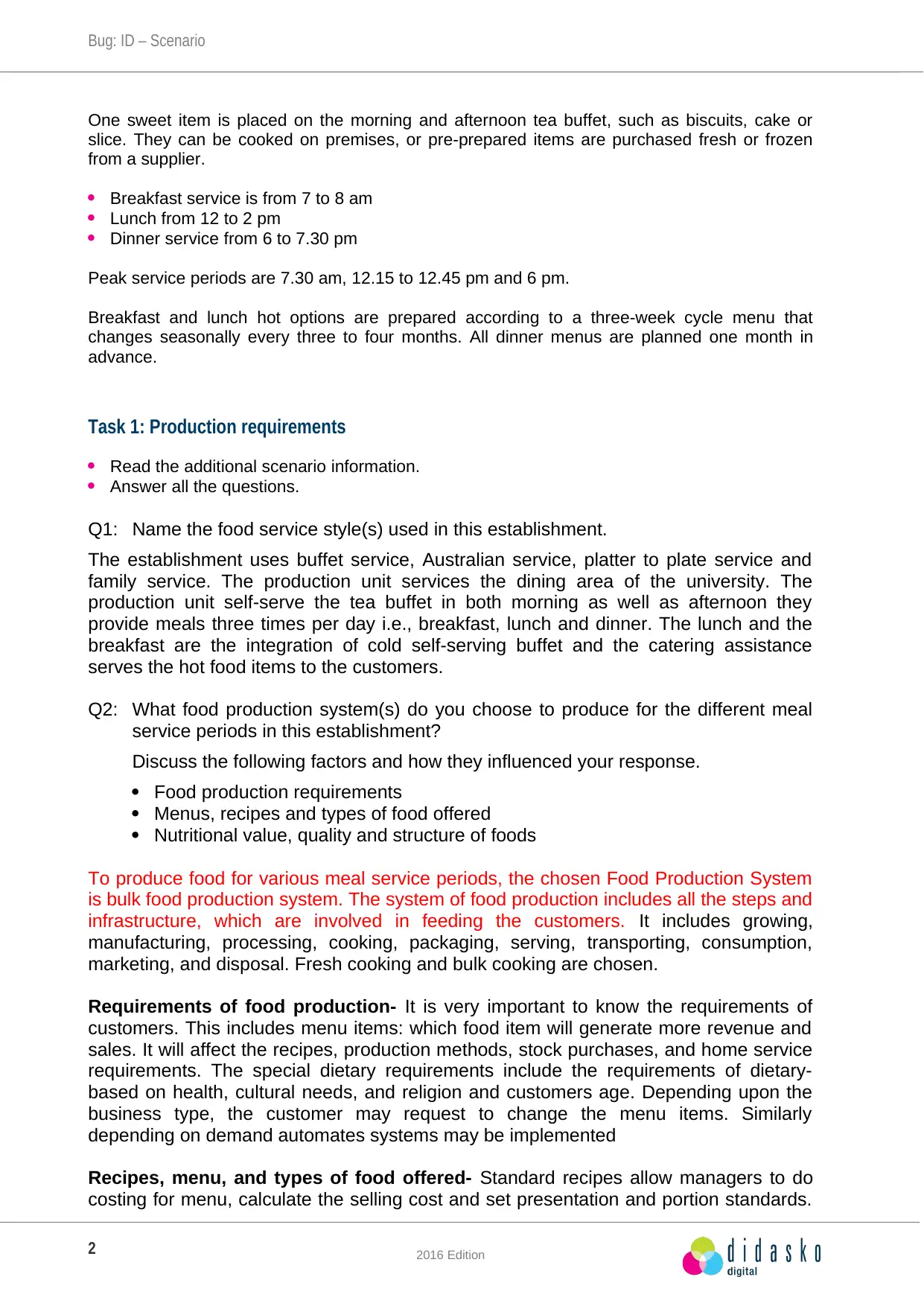
Bug: ID – Scenario
One sweet item is placed on the morning and afternoon tea buffet, such as biscuits, cake or
slice. They can be cooked on premises, or pre-prepared items are purchased fresh or frozen
from a supplier.
Breakfast service is from 7 to 8 am
Lunch from 12 to 2 pm
Dinner service from 6 to 7.30 pm
Peak service periods are 7.30 am, 12.15 to 12.45 pm and 6 pm.
Breakfast and lunch hot options are prepared according to a three-week cycle menu that
changes seasonally every three to four months. All dinner menus are planned one month in
advance.
Task 1: Production requirements
Read the additional scenario information.
Answer all the questions.
Q1: Name the food service style(s) used in this establishment.
The establishment uses buffet service, Australian service, platter to plate service and
family service. The production unit services the dining area of the university. The
production unit self-serve the tea buffet in both morning as well as afternoon they
provide meals three times per day i.e., breakfast, lunch and dinner. The lunch and the
breakfast are the integration of cold self-serving buffet and the catering assistance
serves the hot food items to the customers.
Q2: What food production system(s) do you choose to produce for the different meal
service periods in this establishment?
Discuss the following factors and how they influenced your response.
Food production requirements
Menus, recipes and types of food offered
Nutritional value, quality and structure of foods
To produce food for various meal service periods, the chosen Food Production System
is bulk food production system. The system of food production includes all the steps and
infrastructure, which are involved in feeding the customers. It includes growing,
manufacturing, processing, cooking, packaging, serving, transporting, consumption,
marketing, and disposal. Fresh cooking and bulk cooking are chosen.
Requirements of food production- It is very important to know the requirements of
customers. This includes menu items: which food item will generate more revenue and
sales. It will affect the recipes, production methods, stock purchases, and home service
requirements. The special dietary requirements include the requirements of dietary-
based on health, cultural needs, and religion and customers age. Depending upon the
business type, the customer may request to change the menu items. Similarly
depending on demand automates systems may be implemented
Recipes, menu, and types of food offered- Standard recipes allow managers to do
costing for menu, calculate the selling cost and set presentation and portion standards.
2016 Edition2
One sweet item is placed on the morning and afternoon tea buffet, such as biscuits, cake or
slice. They can be cooked on premises, or pre-prepared items are purchased fresh or frozen
from a supplier.
Breakfast service is from 7 to 8 am
Lunch from 12 to 2 pm
Dinner service from 6 to 7.30 pm
Peak service periods are 7.30 am, 12.15 to 12.45 pm and 6 pm.
Breakfast and lunch hot options are prepared according to a three-week cycle menu that
changes seasonally every three to four months. All dinner menus are planned one month in
advance.
Task 1: Production requirements
Read the additional scenario information.
Answer all the questions.
Q1: Name the food service style(s) used in this establishment.
The establishment uses buffet service, Australian service, platter to plate service and
family service. The production unit services the dining area of the university. The
production unit self-serve the tea buffet in both morning as well as afternoon they
provide meals three times per day i.e., breakfast, lunch and dinner. The lunch and the
breakfast are the integration of cold self-serving buffet and the catering assistance
serves the hot food items to the customers.
Q2: What food production system(s) do you choose to produce for the different meal
service periods in this establishment?
Discuss the following factors and how they influenced your response.
Food production requirements
Menus, recipes and types of food offered
Nutritional value, quality and structure of foods
To produce food for various meal service periods, the chosen Food Production System
is bulk food production system. The system of food production includes all the steps and
infrastructure, which are involved in feeding the customers. It includes growing,
manufacturing, processing, cooking, packaging, serving, transporting, consumption,
marketing, and disposal. Fresh cooking and bulk cooking are chosen.
Requirements of food production- It is very important to know the requirements of
customers. This includes menu items: which food item will generate more revenue and
sales. It will affect the recipes, production methods, stock purchases, and home service
requirements. The special dietary requirements include the requirements of dietary-
based on health, cultural needs, and religion and customers age. Depending upon the
business type, the customer may request to change the menu items. Similarly
depending on demand automates systems may be implemented
Recipes, menu, and types of food offered- Standard recipes allow managers to do
costing for menu, calculate the selling cost and set presentation and portion standards.
2016 Edition2
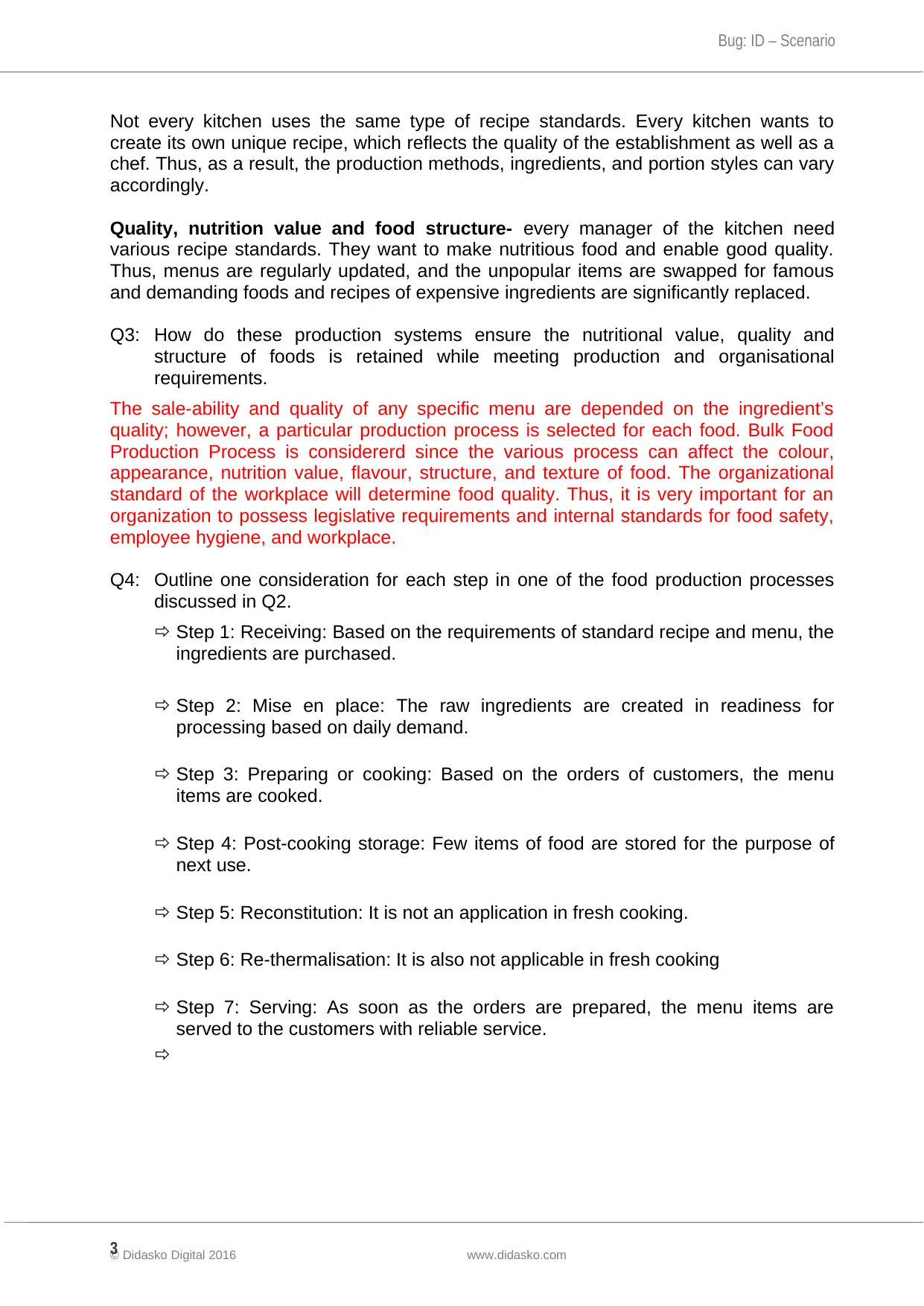
Bug: ID – Scenario
Not every kitchen uses the same type of recipe standards. Every kitchen wants to
create its own unique recipe, which reflects the quality of the establishment as well as a
chef. Thus, as a result, the production methods, ingredients, and portion styles can vary
accordingly.
Quality, nutrition value and food structure- every manager of the kitchen need
various recipe standards. They want to make nutritious food and enable good quality.
Thus, menus are regularly updated, and the unpopular items are swapped for famous
and demanding foods and recipes of expensive ingredients are significantly replaced.
Q3: How do these production systems ensure the nutritional value, quality and
structure of foods is retained while meeting production and organisational
requirements.
The sale-ability and quality of any specific menu are depended on the ingredient’s
quality; however, a particular production process is selected for each food. Bulk Food
Production Process is considererd since the various process can affect the colour,
appearance, nutrition value, flavour, structure, and texture of food. The organizational
standard of the workplace will determine food quality. Thus, it is very important for an
organization to possess legislative requirements and internal standards for food safety,
employee hygiene, and workplace.
Q4: Outline one consideration for each step in one of the food production processes
discussed in Q2.
Step 1: Receiving: Based on the requirements of standard recipe and menu, the
ingredients are purchased.
Step 2: Mise en place: The raw ingredients are created in readiness for
processing based on daily demand.
Step 3: Preparing or cooking: Based on the orders of customers, the menu
items are cooked.
Step 4: Post-cooking storage: Few items of food are stored for the purpose of
next use.
Step 5: Reconstitution: It is not an application in fresh cooking.
Step 6: Re-thermalisation: It is also not applicable in fresh cooking
Step 7: Serving: As soon as the orders are prepared, the menu items are
served to the customers with reliable service.
© Didasko Digital 2016 www.didasko.com3
Not every kitchen uses the same type of recipe standards. Every kitchen wants to
create its own unique recipe, which reflects the quality of the establishment as well as a
chef. Thus, as a result, the production methods, ingredients, and portion styles can vary
accordingly.
Quality, nutrition value and food structure- every manager of the kitchen need
various recipe standards. They want to make nutritious food and enable good quality.
Thus, menus are regularly updated, and the unpopular items are swapped for famous
and demanding foods and recipes of expensive ingredients are significantly replaced.
Q3: How do these production systems ensure the nutritional value, quality and
structure of foods is retained while meeting production and organisational
requirements.
The sale-ability and quality of any specific menu are depended on the ingredient’s
quality; however, a particular production process is selected for each food. Bulk Food
Production Process is considererd since the various process can affect the colour,
appearance, nutrition value, flavour, structure, and texture of food. The organizational
standard of the workplace will determine food quality. Thus, it is very important for an
organization to possess legislative requirements and internal standards for food safety,
employee hygiene, and workplace.
Q4: Outline one consideration for each step in one of the food production processes
discussed in Q2.
Step 1: Receiving: Based on the requirements of standard recipe and menu, the
ingredients are purchased.
Step 2: Mise en place: The raw ingredients are created in readiness for
processing based on daily demand.
Step 3: Preparing or cooking: Based on the orders of customers, the menu
items are cooked.
Step 4: Post-cooking storage: Few items of food are stored for the purpose of
next use.
Step 5: Reconstitution: It is not an application in fresh cooking.
Step 6: Re-thermalisation: It is also not applicable in fresh cooking
Step 7: Serving: As soon as the orders are prepared, the menu items are
served to the customers with reliable service.
© Didasko Digital 2016 www.didasko.com3
⊘ This is a preview!⊘
Do you want full access?
Subscribe today to unlock all pages.

Trusted by 1+ million students worldwide
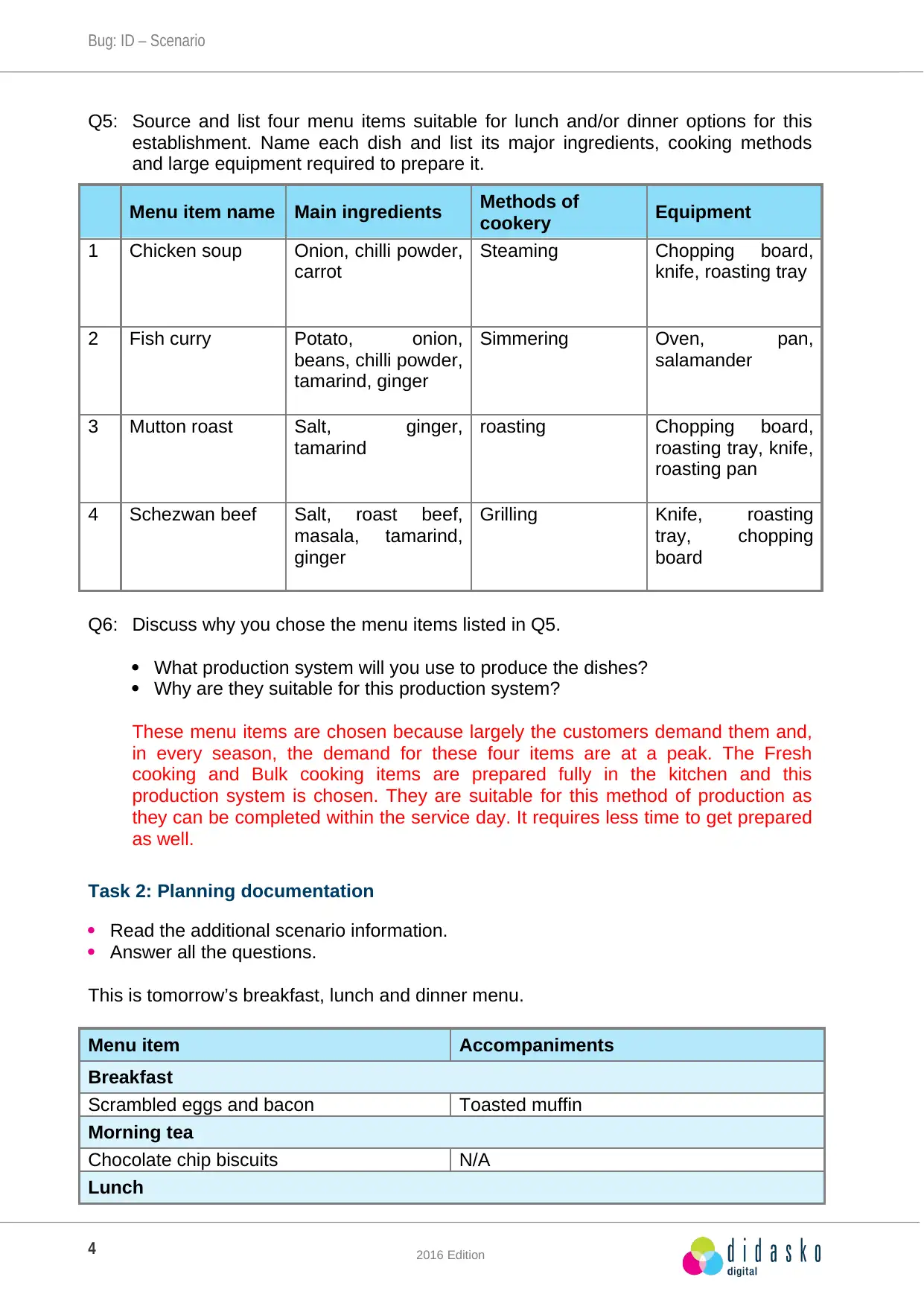
Bug: ID – Scenario
Q5: Source and list four menu items suitable for lunch and/or dinner options for this
establishment. Name each dish and list its major ingredients, cooking methods
and large equipment required to prepare it.
Menu item name Main ingredients Methods of
cookery Equipment
1 Chicken soup Onion, chilli powder,
carrot
Steaming Chopping board,
knife, roasting tray
2 Fish curry Potato, onion,
beans, chilli powder,
tamarind, ginger
Simmering Oven, pan,
salamander
3 Mutton roast Salt, ginger,
tamarind
roasting Chopping board,
roasting tray, knife,
roasting pan
4 Schezwan beef Salt, roast beef,
masala, tamarind,
ginger
Grilling Knife, roasting
tray, chopping
board
Q6: Discuss why you chose the menu items listed in Q5.
What production system will you use to produce the dishes?
Why are they suitable for this production system?
These menu items are chosen because largely the customers demand them and,
in every season, the demand for these four items are at a peak. The Fresh
cooking and Bulk cooking items are prepared fully in the kitchen and this
production system is chosen. They are suitable for this method of production as
they can be completed within the service day. It requires less time to get prepared
as well.
Task 2: Planning documentation
Read the additional scenario information.
Answer all the questions.
This is tomorrow’s breakfast, lunch and dinner menu.
Menu item Accompaniments
Breakfast
Scrambled eggs and bacon Toasted muffin
Morning tea
Chocolate chip biscuits N/A
Lunch
2016 Edition4
Q5: Source and list four menu items suitable for lunch and/or dinner options for this
establishment. Name each dish and list its major ingredients, cooking methods
and large equipment required to prepare it.
Menu item name Main ingredients Methods of
cookery Equipment
1 Chicken soup Onion, chilli powder,
carrot
Steaming Chopping board,
knife, roasting tray
2 Fish curry Potato, onion,
beans, chilli powder,
tamarind, ginger
Simmering Oven, pan,
salamander
3 Mutton roast Salt, ginger,
tamarind
roasting Chopping board,
roasting tray, knife,
roasting pan
4 Schezwan beef Salt, roast beef,
masala, tamarind,
ginger
Grilling Knife, roasting
tray, chopping
board
Q6: Discuss why you chose the menu items listed in Q5.
What production system will you use to produce the dishes?
Why are they suitable for this production system?
These menu items are chosen because largely the customers demand them and,
in every season, the demand for these four items are at a peak. The Fresh
cooking and Bulk cooking items are prepared fully in the kitchen and this
production system is chosen. They are suitable for this method of production as
they can be completed within the service day. It requires less time to get prepared
as well.
Task 2: Planning documentation
Read the additional scenario information.
Answer all the questions.
This is tomorrow’s breakfast, lunch and dinner menu.
Menu item Accompaniments
Breakfast
Scrambled eggs and bacon Toasted muffin
Morning tea
Chocolate chip biscuits N/A
Lunch
2016 Edition4
Paraphrase This Document
Need a fresh take? Get an instant paraphrase of this document with our AI Paraphraser
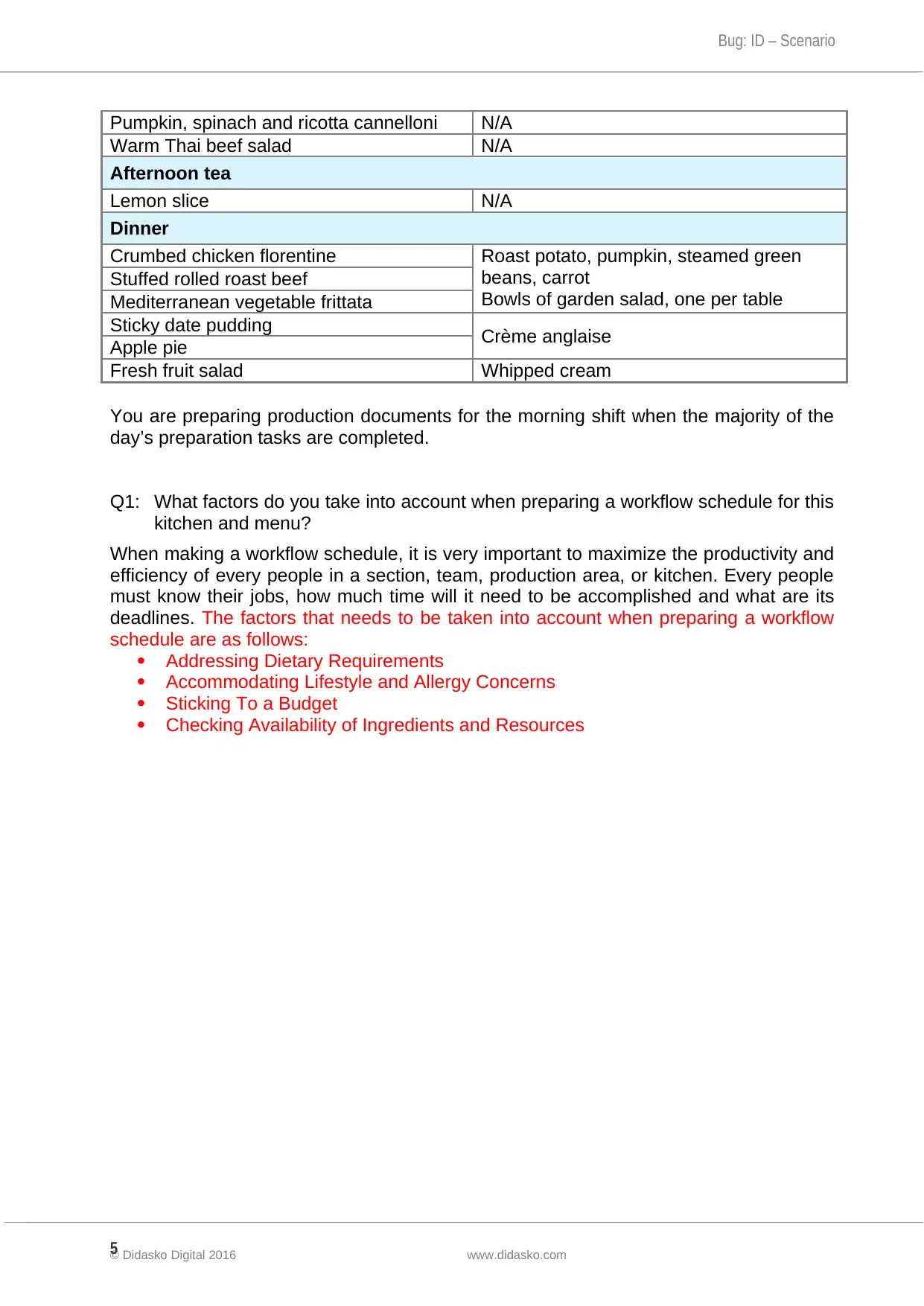
Bug: ID – Scenario
Pumpkin, spinach and ricotta cannelloni N/A
Warm Thai beef salad N/A
Afternoon tea
Lemon slice N/A
Dinner
Crumbed chicken florentine Roast potato, pumpkin, steamed green
beans, carrot
Bowls of garden salad, one per table
Stuffed rolled roast beef
Mediterranean vegetable frittata
Sticky date pudding Crème anglaise
Apple pie
Fresh fruit salad Whipped cream
You are preparing production documents for the morning shift when the majority of the
day’s preparation tasks are completed.
Q1: What factors do you take into account when preparing a workflow schedule for this
kitchen and menu?
When making a workflow schedule, it is very important to maximize the productivity and
efficiency of every people in a section, team, production area, or kitchen. Every people
must know their jobs, how much time will it need to be accomplished and what are its
deadlines. The factors that needs to be taken into account when preparing a workflow
schedule are as follows:
Addressing Dietary Requirements
Accommodating Lifestyle and Allergy Concerns
Sticking To a Budget
Checking Availability of Ingredients and Resources
© Didasko Digital 2016 www.didasko.com5
Pumpkin, spinach and ricotta cannelloni N/A
Warm Thai beef salad N/A
Afternoon tea
Lemon slice N/A
Dinner
Crumbed chicken florentine Roast potato, pumpkin, steamed green
beans, carrot
Bowls of garden salad, one per table
Stuffed rolled roast beef
Mediterranean vegetable frittata
Sticky date pudding Crème anglaise
Apple pie
Fresh fruit salad Whipped cream
You are preparing production documents for the morning shift when the majority of the
day’s preparation tasks are completed.
Q1: What factors do you take into account when preparing a workflow schedule for this
kitchen and menu?
When making a workflow schedule, it is very important to maximize the productivity and
efficiency of every people in a section, team, production area, or kitchen. Every people
must know their jobs, how much time will it need to be accomplished and what are its
deadlines. The factors that needs to be taken into account when preparing a workflow
schedule are as follows:
Addressing Dietary Requirements
Accommodating Lifestyle and Allergy Concerns
Sticking To a Budget
Checking Availability of Ingredients and Resources
© Didasko Digital 2016 www.didasko.com5
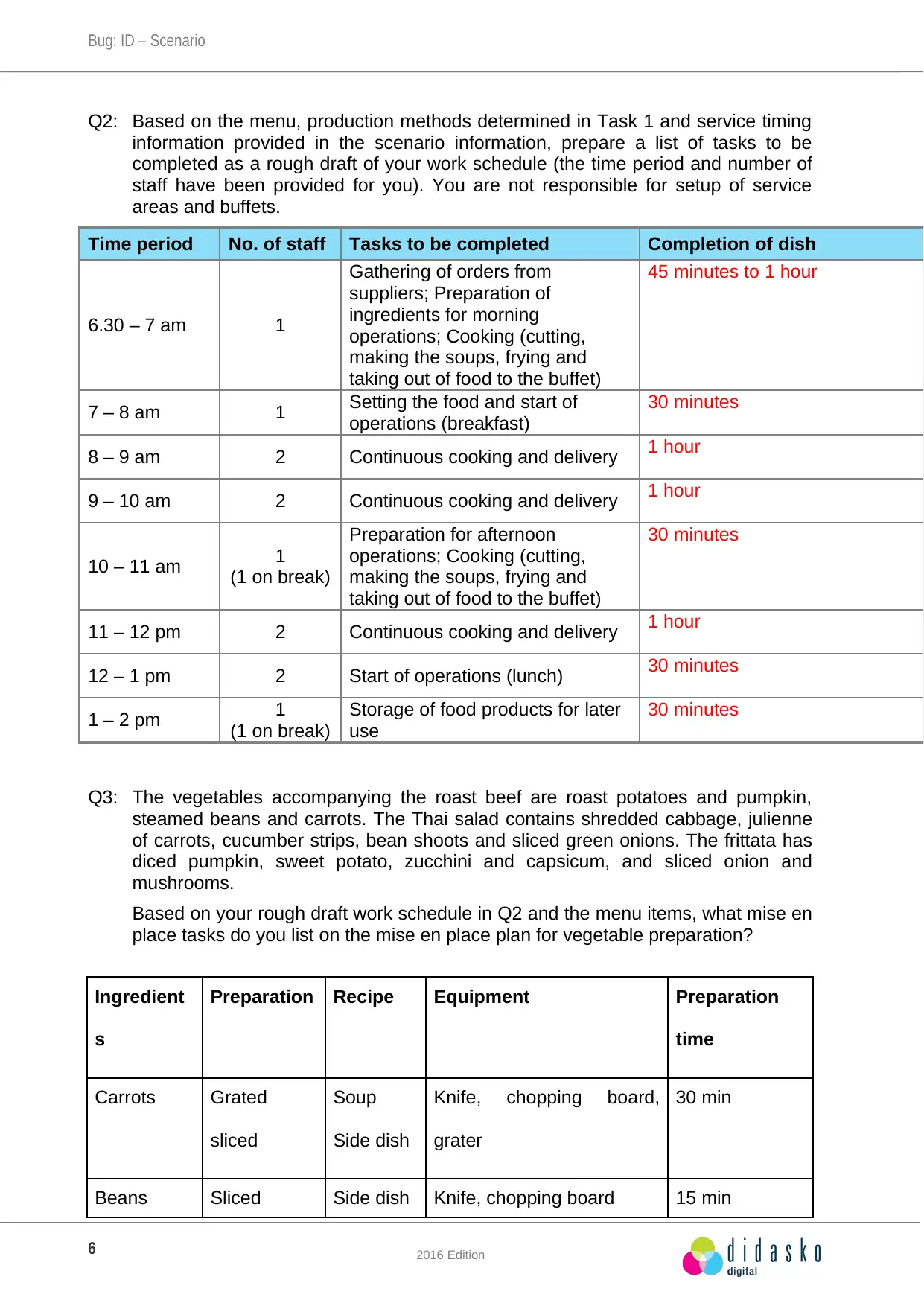
Bug: ID – Scenario
Q2: Based on the menu, production methods determined in Task 1 and service timing
information provided in the scenario information, prepare a list of tasks to be
completed as a rough draft of your work schedule (the time period and number of
staff have been provided for you). You are not responsible for setup of service
areas and buffets.
Time period No. of staff Tasks to be completed Completion of dish
6.30 – 7 am 1
Gathering of orders from
suppliers; Preparation of
ingredients for morning
operations; Cooking (cutting,
making the soups, frying and
taking out of food to the buffet)
45 minutes to 1 hour
7 – 8 am 1 Setting the food and start of
operations (breakfast)
30 minutes
8 – 9 am 2 Continuous cooking and delivery 1 hour
9 – 10 am 2 Continuous cooking and delivery 1 hour
10 – 11 am 1
(1 on break)
Preparation for afternoon
operations; Cooking (cutting,
making the soups, frying and
taking out of food to the buffet)
30 minutes
11 – 12 pm 2 Continuous cooking and delivery 1 hour
12 – 1 pm 2 Start of operations (lunch) 30 minutes
1 – 2 pm 1
(1 on break)
Storage of food products for later
use
30 minutes
Q3: The vegetables accompanying the roast beef are roast potatoes and pumpkin,
steamed beans and carrots. The Thai salad contains shredded cabbage, julienne
of carrots, cucumber strips, bean shoots and sliced green onions. The frittata has
diced pumpkin, sweet potato, zucchini and capsicum, and sliced onion and
mushrooms.
Based on your rough draft work schedule in Q2 and the menu items, what mise en
place tasks do you list on the mise en place plan for vegetable preparation?
Ingredient
s
Preparation Recipe Equipment Preparation
time
Carrots Grated
sliced
Soup
Side dish
Knife, chopping board,
grater
30 min
Beans Sliced Side dish Knife, chopping board 15 min
2016 Edition6
Q2: Based on the menu, production methods determined in Task 1 and service timing
information provided in the scenario information, prepare a list of tasks to be
completed as a rough draft of your work schedule (the time period and number of
staff have been provided for you). You are not responsible for setup of service
areas and buffets.
Time period No. of staff Tasks to be completed Completion of dish
6.30 – 7 am 1
Gathering of orders from
suppliers; Preparation of
ingredients for morning
operations; Cooking (cutting,
making the soups, frying and
taking out of food to the buffet)
45 minutes to 1 hour
7 – 8 am 1 Setting the food and start of
operations (breakfast)
30 minutes
8 – 9 am 2 Continuous cooking and delivery 1 hour
9 – 10 am 2 Continuous cooking and delivery 1 hour
10 – 11 am 1
(1 on break)
Preparation for afternoon
operations; Cooking (cutting,
making the soups, frying and
taking out of food to the buffet)
30 minutes
11 – 12 pm 2 Continuous cooking and delivery 1 hour
12 – 1 pm 2 Start of operations (lunch) 30 minutes
1 – 2 pm 1
(1 on break)
Storage of food products for later
use
30 minutes
Q3: The vegetables accompanying the roast beef are roast potatoes and pumpkin,
steamed beans and carrots. The Thai salad contains shredded cabbage, julienne
of carrots, cucumber strips, bean shoots and sliced green onions. The frittata has
diced pumpkin, sweet potato, zucchini and capsicum, and sliced onion and
mushrooms.
Based on your rough draft work schedule in Q2 and the menu items, what mise en
place tasks do you list on the mise en place plan for vegetable preparation?
Ingredient
s
Preparation Recipe Equipment Preparation
time
Carrots Grated
sliced
Soup
Side dish
Knife, chopping board,
grater
30 min
Beans Sliced Side dish Knife, chopping board 15 min
2016 Edition6
⊘ This is a preview!⊘
Do you want full access?
Subscribe today to unlock all pages.

Trusted by 1+ million students worldwide
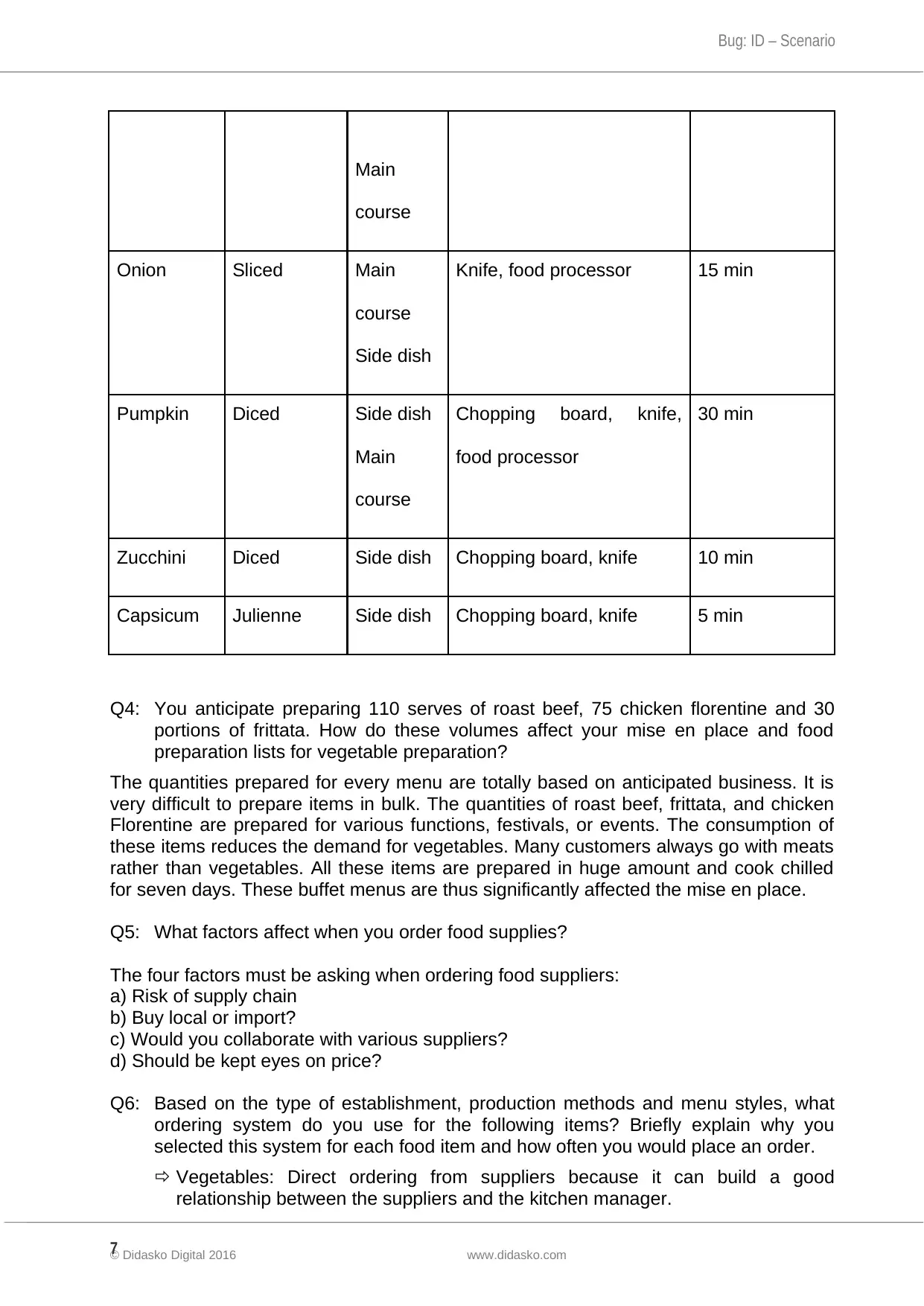
Bug: ID – Scenario
Main
course
Onion Sliced Main
course
Side dish
Knife, food processor 15 min
Pumpkin Diced Side dish
Main
course
Chopping board, knife,
food processor
30 min
Zucchini Diced Side dish Chopping board, knife 10 min
Capsicum Julienne Side dish Chopping board, knife 5 min
Q4: You anticipate preparing 110 serves of roast beef, 75 chicken florentine and 30
portions of frittata. How do these volumes affect your mise en place and food
preparation lists for vegetable preparation?
The quantities prepared for every menu are totally based on anticipated business. It is
very difficult to prepare items in bulk. The quantities of roast beef, frittata, and chicken
Florentine are prepared for various functions, festivals, or events. The consumption of
these items reduces the demand for vegetables. Many customers always go with meats
rather than vegetables. All these items are prepared in huge amount and cook chilled
for seven days. These buffet menus are thus significantly affected the mise en place.
Q5: What factors affect when you order food supplies?
The four factors must be asking when ordering food suppliers:
a) Risk of supply chain
b) Buy local or import?
c) Would you collaborate with various suppliers?
d) Should be kept eyes on price?
Q6: Based on the type of establishment, production methods and menu styles, what
ordering system do you use for the following items? Briefly explain why you
selected this system for each food item and how often you would place an order.
Vegetables: Direct ordering from suppliers because it can build a good
relationship between the suppliers and the kitchen manager.
© Didasko Digital 2016 www.didasko.com7
Main
course
Onion Sliced Main
course
Side dish
Knife, food processor 15 min
Pumpkin Diced Side dish
Main
course
Chopping board, knife,
food processor
30 min
Zucchini Diced Side dish Chopping board, knife 10 min
Capsicum Julienne Side dish Chopping board, knife 5 min
Q4: You anticipate preparing 110 serves of roast beef, 75 chicken florentine and 30
portions of frittata. How do these volumes affect your mise en place and food
preparation lists for vegetable preparation?
The quantities prepared for every menu are totally based on anticipated business. It is
very difficult to prepare items in bulk. The quantities of roast beef, frittata, and chicken
Florentine are prepared for various functions, festivals, or events. The consumption of
these items reduces the demand for vegetables. Many customers always go with meats
rather than vegetables. All these items are prepared in huge amount and cook chilled
for seven days. These buffet menus are thus significantly affected the mise en place.
Q5: What factors affect when you order food supplies?
The four factors must be asking when ordering food suppliers:
a) Risk of supply chain
b) Buy local or import?
c) Would you collaborate with various suppliers?
d) Should be kept eyes on price?
Q6: Based on the type of establishment, production methods and menu styles, what
ordering system do you use for the following items? Briefly explain why you
selected this system for each food item and how often you would place an order.
Vegetables: Direct ordering from suppliers because it can build a good
relationship between the suppliers and the kitchen manager.
© Didasko Digital 2016 www.didasko.com7
Paraphrase This Document
Need a fresh take? Get an instant paraphrase of this document with our AI Paraphraser
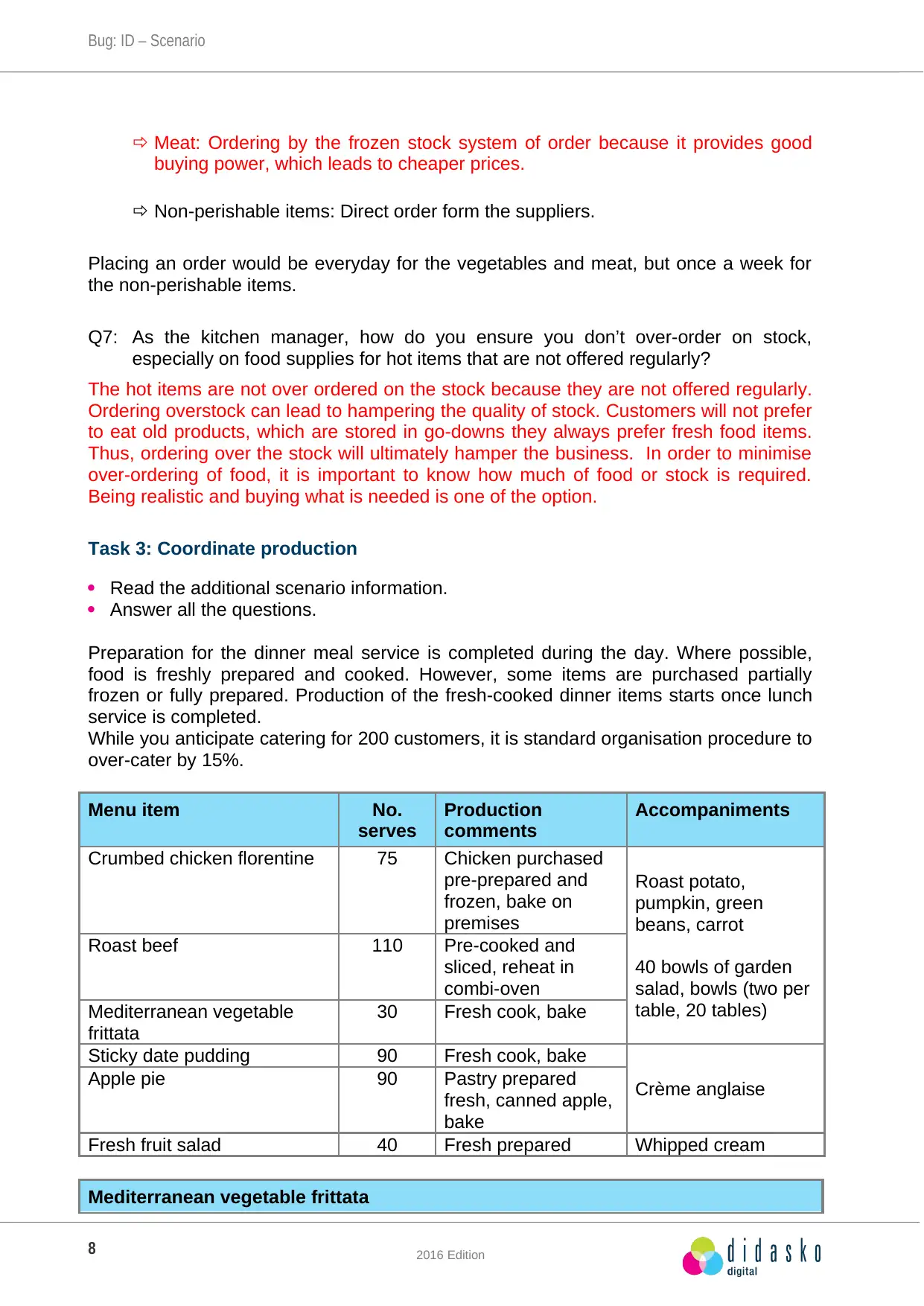
Bug: ID – Scenario
Meat: Ordering by the frozen stock system of order because it provides good
buying power, which leads to cheaper prices.
Non-perishable items: Direct order form the suppliers.
Placing an order would be everyday for the vegetables and meat, but once a week for
the non-perishable items.
Q7: As the kitchen manager, how do you ensure you don’t over-order on stock,
especially on food supplies for hot items that are not offered regularly?
The hot items are not over ordered on the stock because they are not offered regularly.
Ordering overstock can lead to hampering the quality of stock. Customers will not prefer
to eat old products, which are stored in go-downs they always prefer fresh food items.
Thus, ordering over the stock will ultimately hamper the business. In order to minimise
over-ordering of food, it is important to know how much of food or stock is required.
Being realistic and buying what is needed is one of the option.
Task 3: Coordinate production
Read the additional scenario information.
Answer all the questions.
Preparation for the dinner meal service is completed during the day. Where possible,
food is freshly prepared and cooked. However, some items are purchased partially
frozen or fully prepared. Production of the fresh-cooked dinner items starts once lunch
service is completed.
While you anticipate catering for 200 customers, it is standard organisation procedure to
over-cater by 15%.
Menu item No.
serves
Production
comments
Accompaniments
Crumbed chicken florentine 75 Chicken purchased
pre-prepared and
frozen, bake on
premises
Roast potato,
pumpkin, green
beans, carrot
40 bowls of garden
salad, bowls (two per
table, 20 tables)
Roast beef 110 Pre-cooked and
sliced, reheat in
combi-oven
Mediterranean vegetable
frittata
30 Fresh cook, bake
Sticky date pudding 90 Fresh cook, bake
Crème anglaise
Apple pie 90 Pastry prepared
fresh, canned apple,
bake
Fresh fruit salad 40 Fresh prepared Whipped cream
Mediterranean vegetable frittata
2016 Edition8
Meat: Ordering by the frozen stock system of order because it provides good
buying power, which leads to cheaper prices.
Non-perishable items: Direct order form the suppliers.
Placing an order would be everyday for the vegetables and meat, but once a week for
the non-perishable items.
Q7: As the kitchen manager, how do you ensure you don’t over-order on stock,
especially on food supplies for hot items that are not offered regularly?
The hot items are not over ordered on the stock because they are not offered regularly.
Ordering overstock can lead to hampering the quality of stock. Customers will not prefer
to eat old products, which are stored in go-downs they always prefer fresh food items.
Thus, ordering over the stock will ultimately hamper the business. In order to minimise
over-ordering of food, it is important to know how much of food or stock is required.
Being realistic and buying what is needed is one of the option.
Task 3: Coordinate production
Read the additional scenario information.
Answer all the questions.
Preparation for the dinner meal service is completed during the day. Where possible,
food is freshly prepared and cooked. However, some items are purchased partially
frozen or fully prepared. Production of the fresh-cooked dinner items starts once lunch
service is completed.
While you anticipate catering for 200 customers, it is standard organisation procedure to
over-cater by 15%.
Menu item No.
serves
Production
comments
Accompaniments
Crumbed chicken florentine 75 Chicken purchased
pre-prepared and
frozen, bake on
premises
Roast potato,
pumpkin, green
beans, carrot
40 bowls of garden
salad, bowls (two per
table, 20 tables)
Roast beef 110 Pre-cooked and
sliced, reheat in
combi-oven
Mediterranean vegetable
frittata
30 Fresh cook, bake
Sticky date pudding 90 Fresh cook, bake
Crème anglaise
Apple pie 90 Pastry prepared
fresh, canned apple,
bake
Fresh fruit salad 40 Fresh prepared Whipped cream
Mediterranean vegetable frittata
2016 Edition8
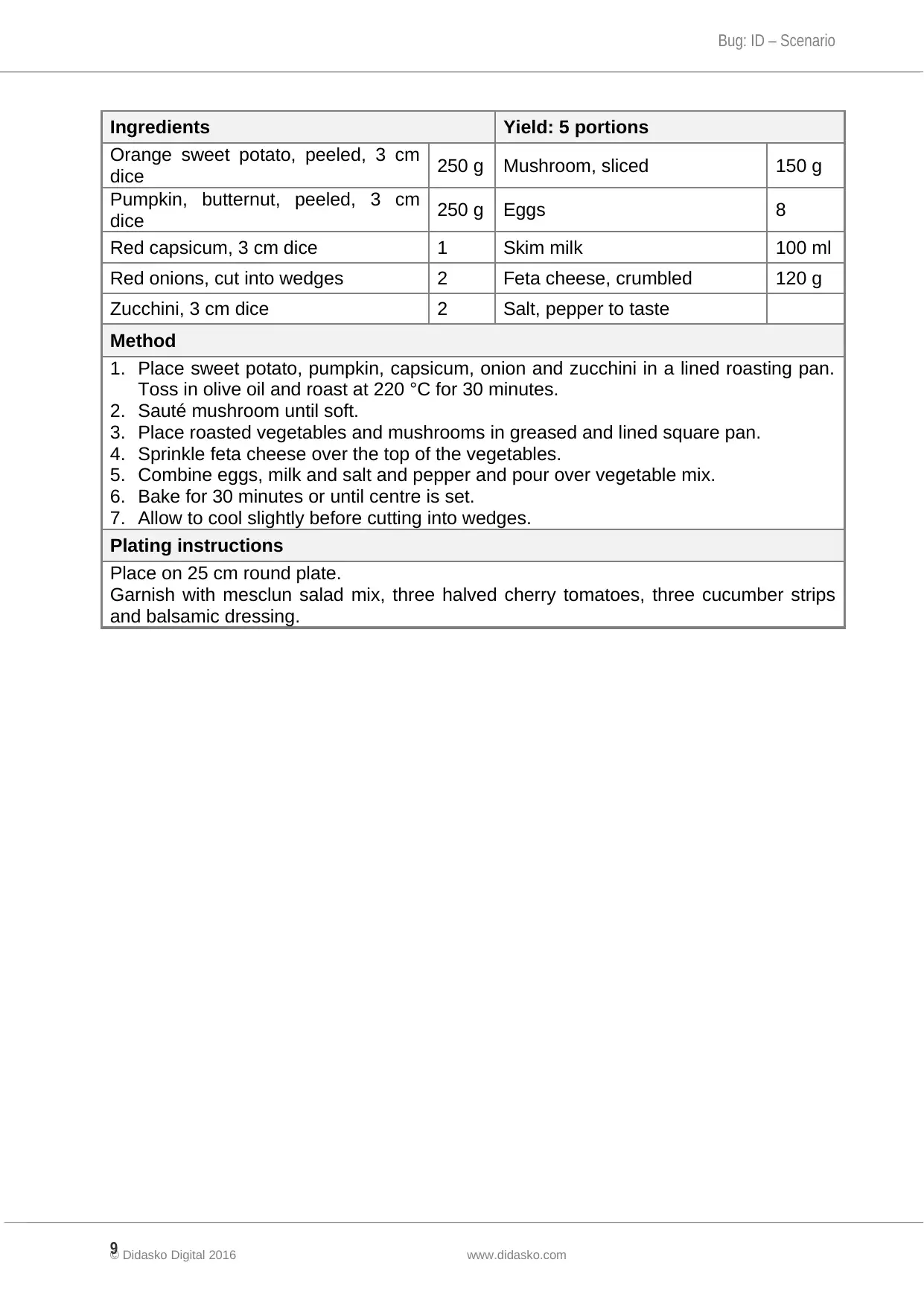
Bug: ID – Scenario
Ingredients Yield: 5 portions
Orange sweet potato, peeled, 3 cm
dice 250 g Mushroom, sliced 150 g
Pumpkin, butternut, peeled, 3 cm
dice 250 g Eggs 8
Red capsicum, 3 cm dice 1 Skim milk 100 ml
Red onions, cut into wedges 2 Feta cheese, crumbled 120 g
Zucchini, 3 cm dice 2 Salt, pepper to taste
Method
1. Place sweet potato, pumpkin, capsicum, onion and zucchini in a lined roasting pan.
Toss in olive oil and roast at 220 °C for 30 minutes.
2. Sauté mushroom until soft.
3. Place roasted vegetables and mushrooms in greased and lined square pan.
4. Sprinkle feta cheese over the top of the vegetables.
5. Combine eggs, milk and salt and pepper and pour over vegetable mix.
6. Bake for 30 minutes or until centre is set.
7. Allow to cool slightly before cutting into wedges.
Plating instructions
Place on 25 cm round plate.
Garnish with mesclun salad mix, three halved cherry tomatoes, three cucumber strips
and balsamic dressing.
© Didasko Digital 2016 www.didasko.com9
Ingredients Yield: 5 portions
Orange sweet potato, peeled, 3 cm
dice 250 g Mushroom, sliced 150 g
Pumpkin, butternut, peeled, 3 cm
dice 250 g Eggs 8
Red capsicum, 3 cm dice 1 Skim milk 100 ml
Red onions, cut into wedges 2 Feta cheese, crumbled 120 g
Zucchini, 3 cm dice 2 Salt, pepper to taste
Method
1. Place sweet potato, pumpkin, capsicum, onion and zucchini in a lined roasting pan.
Toss in olive oil and roast at 220 °C for 30 minutes.
2. Sauté mushroom until soft.
3. Place roasted vegetables and mushrooms in greased and lined square pan.
4. Sprinkle feta cheese over the top of the vegetables.
5. Combine eggs, milk and salt and pepper and pour over vegetable mix.
6. Bake for 30 minutes or until centre is set.
7. Allow to cool slightly before cutting into wedges.
Plating instructions
Place on 25 cm round plate.
Garnish with mesclun salad mix, three halved cherry tomatoes, three cucumber strips
and balsamic dressing.
© Didasko Digital 2016 www.didasko.com9
⊘ This is a preview!⊘
Do you want full access?
Subscribe today to unlock all pages.

Trusted by 1+ million students worldwide
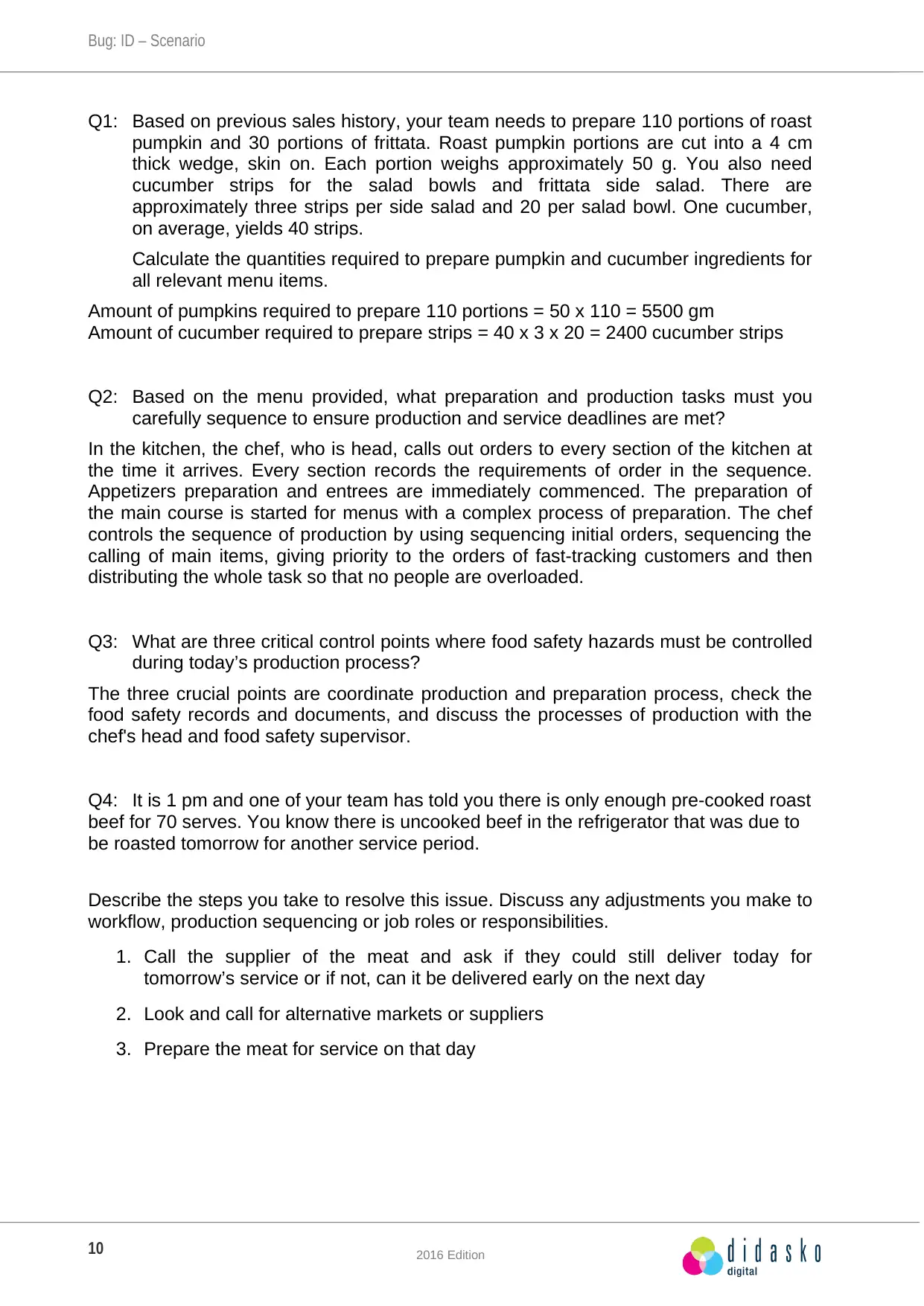
Bug: ID – Scenario
Q1: Based on previous sales history, your team needs to prepare 110 portions of roast
pumpkin and 30 portions of frittata. Roast pumpkin portions are cut into a 4 cm
thick wedge, skin on. Each portion weighs approximately 50 g. You also need
cucumber strips for the salad bowls and frittata side salad. There are
approximately three strips per side salad and 20 per salad bowl. One cucumber,
on average, yields 40 strips.
Calculate the quantities required to prepare pumpkin and cucumber ingredients for
all relevant menu items.
Amount of pumpkins required to prepare 110 portions = 50 x 110 = 5500 gm
Amount of cucumber required to prepare strips = 40 x 3 x 20 = 2400 cucumber strips
Q2: Based on the menu provided, what preparation and production tasks must you
carefully sequence to ensure production and service deadlines are met?
In the kitchen, the chef, who is head, calls out orders to every section of the kitchen at
the time it arrives. Every section records the requirements of order in the sequence.
Appetizers preparation and entrees are immediately commenced. The preparation of
the main course is started for menus with a complex process of preparation. The chef
controls the sequence of production by using sequencing initial orders, sequencing the
calling of main items, giving priority to the orders of fast-tracking customers and then
distributing the whole task so that no people are overloaded.
Q3: What are three critical control points where food safety hazards must be controlled
during today’s production process?
The three crucial points are coordinate production and preparation process, check the
food safety records and documents, and discuss the processes of production with the
chef's head and food safety supervisor.
Q4: It is 1 pm and one of your team has told you there is only enough pre-cooked roast
beef for 70 serves. You know there is uncooked beef in the refrigerator that was due to
be roasted tomorrow for another service period.
Describe the steps you take to resolve this issue. Discuss any adjustments you make to
workflow, production sequencing or job roles or responsibilities.
1. Call the supplier of the meat and ask if they could still deliver today for
tomorrow’s service or if not, can it be delivered early on the next day
2. Look and call for alternative markets or suppliers
3. Prepare the meat for service on that day
2016 Edition10
Q1: Based on previous sales history, your team needs to prepare 110 portions of roast
pumpkin and 30 portions of frittata. Roast pumpkin portions are cut into a 4 cm
thick wedge, skin on. Each portion weighs approximately 50 g. You also need
cucumber strips for the salad bowls and frittata side salad. There are
approximately three strips per side salad and 20 per salad bowl. One cucumber,
on average, yields 40 strips.
Calculate the quantities required to prepare pumpkin and cucumber ingredients for
all relevant menu items.
Amount of pumpkins required to prepare 110 portions = 50 x 110 = 5500 gm
Amount of cucumber required to prepare strips = 40 x 3 x 20 = 2400 cucumber strips
Q2: Based on the menu provided, what preparation and production tasks must you
carefully sequence to ensure production and service deadlines are met?
In the kitchen, the chef, who is head, calls out orders to every section of the kitchen at
the time it arrives. Every section records the requirements of order in the sequence.
Appetizers preparation and entrees are immediately commenced. The preparation of
the main course is started for menus with a complex process of preparation. The chef
controls the sequence of production by using sequencing initial orders, sequencing the
calling of main items, giving priority to the orders of fast-tracking customers and then
distributing the whole task so that no people are overloaded.
Q3: What are three critical control points where food safety hazards must be controlled
during today’s production process?
The three crucial points are coordinate production and preparation process, check the
food safety records and documents, and discuss the processes of production with the
chef's head and food safety supervisor.
Q4: It is 1 pm and one of your team has told you there is only enough pre-cooked roast
beef for 70 serves. You know there is uncooked beef in the refrigerator that was due to
be roasted tomorrow for another service period.
Describe the steps you take to resolve this issue. Discuss any adjustments you make to
workflow, production sequencing or job roles or responsibilities.
1. Call the supplier of the meat and ask if they could still deliver today for
tomorrow’s service or if not, can it be delivered early on the next day
2. Look and call for alternative markets or suppliers
3. Prepare the meat for service on that day
2016 Edition10
Paraphrase This Document
Need a fresh take? Get an instant paraphrase of this document with our AI Paraphraser
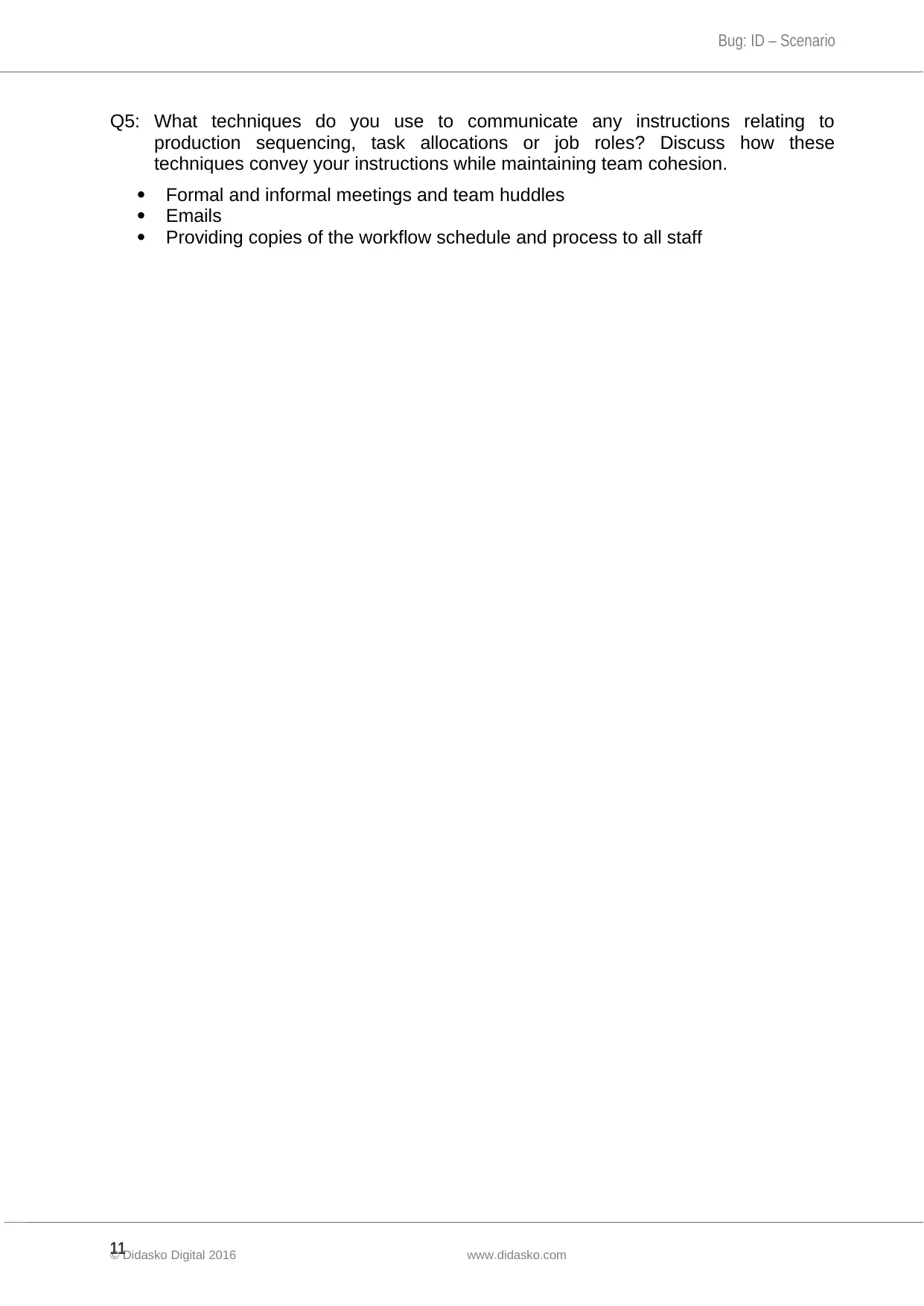
Bug: ID – Scenario
Q5: What techniques do you use to communicate any instructions relating to
production sequencing, task allocations or job roles? Discuss how these
techniques convey your instructions while maintaining team cohesion.
Formal and informal meetings and team huddles
Emails
Providing copies of the workflow schedule and process to all staff
© Didasko Digital 2016 www.didasko.com11
Q5: What techniques do you use to communicate any instructions relating to
production sequencing, task allocations or job roles? Discuss how these
techniques convey your instructions while maintaining team cohesion.
Formal and informal meetings and team huddles
Emails
Providing copies of the workflow schedule and process to all staff
© Didasko Digital 2016 www.didasko.com11
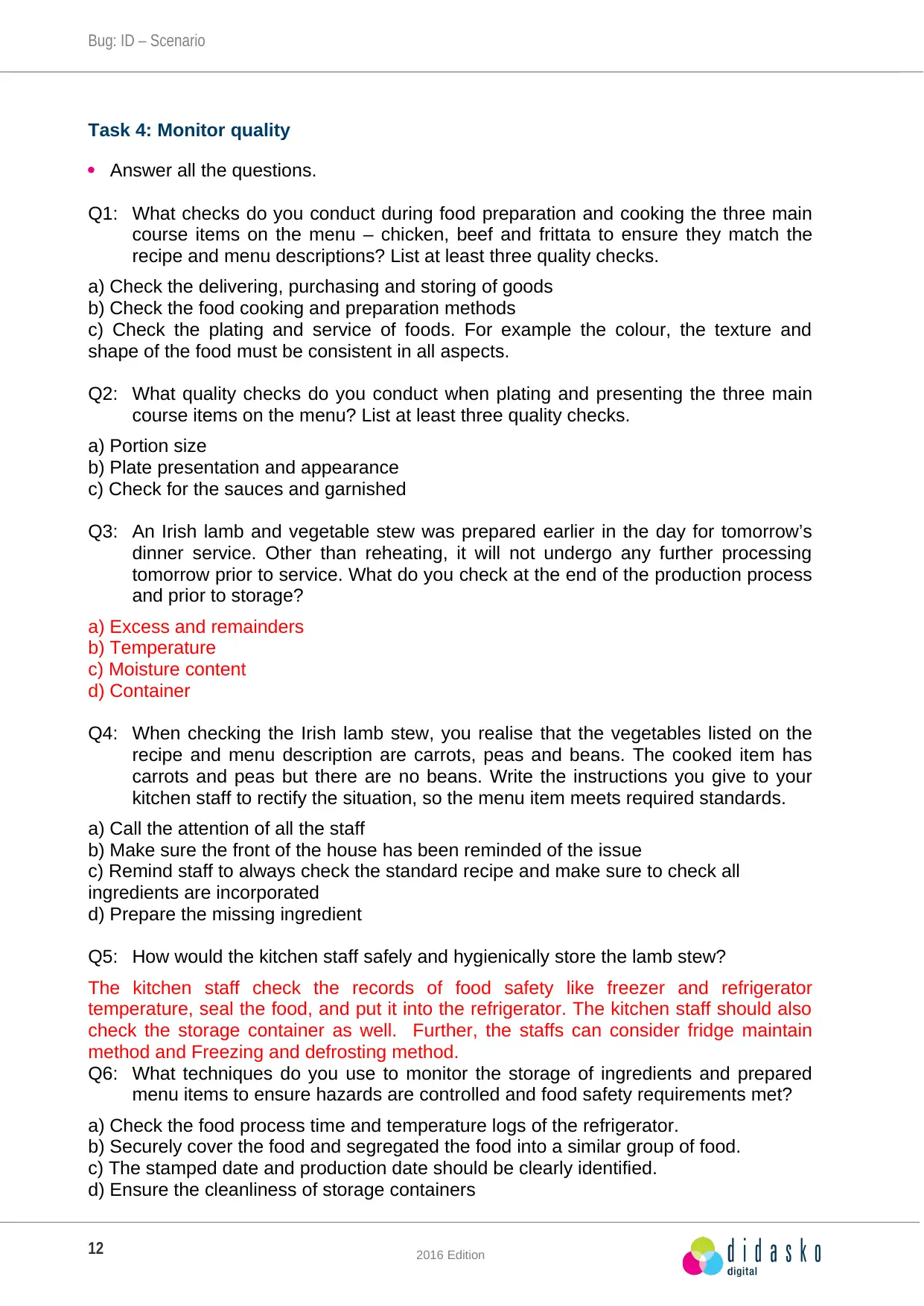
Bug: ID – Scenario
Task 4: Monitor quality
Answer all the questions.
Q1: What checks do you conduct during food preparation and cooking the three main
course items on the menu – chicken, beef and frittata to ensure they match the
recipe and menu descriptions? List at least three quality checks.
a) Check the delivering, purchasing and storing of goods
b) Check the food cooking and preparation methods
c) Check the plating and service of foods. For example the colour, the texture and
shape of the food must be consistent in all aspects.
Q2: What quality checks do you conduct when plating and presenting the three main
course items on the menu? List at least three quality checks.
a) Portion size
b) Plate presentation and appearance
c) Check for the sauces and garnished
Q3: An Irish lamb and vegetable stew was prepared earlier in the day for tomorrow’s
dinner service. Other than reheating, it will not undergo any further processing
tomorrow prior to service. What do you check at the end of the production process
and prior to storage?
a) Excess and remainders
b) Temperature
c) Moisture content
d) Container
Q4: When checking the Irish lamb stew, you realise that the vegetables listed on the
recipe and menu description are carrots, peas and beans. The cooked item has
carrots and peas but there are no beans. Write the instructions you give to your
kitchen staff to rectify the situation, so the menu item meets required standards.
a) Call the attention of all the staff
b) Make sure the front of the house has been reminded of the issue
c) Remind staff to always check the standard recipe and make sure to check all
ingredients are incorporated
d) Prepare the missing ingredient
Q5: How would the kitchen staff safely and hygienically store the lamb stew?
The kitchen staff check the records of food safety like freezer and refrigerator
temperature, seal the food, and put it into the refrigerator. The kitchen staff should also
check the storage container as well. Further, the staffs can consider fridge maintain
method and Freezing and defrosting method.
Q6: What techniques do you use to monitor the storage of ingredients and prepared
menu items to ensure hazards are controlled and food safety requirements met?
a) Check the food process time and temperature logs of the refrigerator.
b) Securely cover the food and segregated the food into a similar group of food.
c) The stamped date and production date should be clearly identified.
d) Ensure the cleanliness of storage containers
2016 Edition12
Task 4: Monitor quality
Answer all the questions.
Q1: What checks do you conduct during food preparation and cooking the three main
course items on the menu – chicken, beef and frittata to ensure they match the
recipe and menu descriptions? List at least three quality checks.
a) Check the delivering, purchasing and storing of goods
b) Check the food cooking and preparation methods
c) Check the plating and service of foods. For example the colour, the texture and
shape of the food must be consistent in all aspects.
Q2: What quality checks do you conduct when plating and presenting the three main
course items on the menu? List at least three quality checks.
a) Portion size
b) Plate presentation and appearance
c) Check for the sauces and garnished
Q3: An Irish lamb and vegetable stew was prepared earlier in the day for tomorrow’s
dinner service. Other than reheating, it will not undergo any further processing
tomorrow prior to service. What do you check at the end of the production process
and prior to storage?
a) Excess and remainders
b) Temperature
c) Moisture content
d) Container
Q4: When checking the Irish lamb stew, you realise that the vegetables listed on the
recipe and menu description are carrots, peas and beans. The cooked item has
carrots and peas but there are no beans. Write the instructions you give to your
kitchen staff to rectify the situation, so the menu item meets required standards.
a) Call the attention of all the staff
b) Make sure the front of the house has been reminded of the issue
c) Remind staff to always check the standard recipe and make sure to check all
ingredients are incorporated
d) Prepare the missing ingredient
Q5: How would the kitchen staff safely and hygienically store the lamb stew?
The kitchen staff check the records of food safety like freezer and refrigerator
temperature, seal the food, and put it into the refrigerator. The kitchen staff should also
check the storage container as well. Further, the staffs can consider fridge maintain
method and Freezing and defrosting method.
Q6: What techniques do you use to monitor the storage of ingredients and prepared
menu items to ensure hazards are controlled and food safety requirements met?
a) Check the food process time and temperature logs of the refrigerator.
b) Securely cover the food and segregated the food into a similar group of food.
c) The stamped date and production date should be clearly identified.
d) Ensure the cleanliness of storage containers
2016 Edition12
⊘ This is a preview!⊘
Do you want full access?
Subscribe today to unlock all pages.

Trusted by 1+ million students worldwide
1 out of 14
Your All-in-One AI-Powered Toolkit for Academic Success.
+13062052269
info@desklib.com
Available 24*7 on WhatsApp / Email
![[object Object]](/_next/static/media/star-bottom.7253800d.svg)
Unlock your academic potential
Copyright © 2020–2025 A2Z Services. All Rights Reserved. Developed and managed by ZUCOL.
